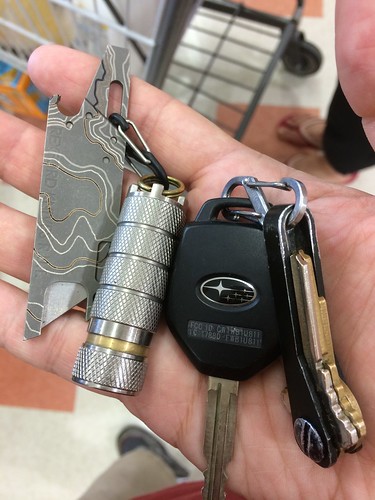Trolling for Hate: Magical Thinking
A recent study, conducted by Professors Jesse Prinz and Angelika Seidel of City University of New York, posed the following question:
The same thing has happened with patches. I recently commented on a Prometheus Design Werx Instagram post of an Emerson patch. I simply wrote: "Knives not patches." This is, of course, heresy to some and I was lambasted for my comment. But the reality is, the patch craze is nothing more than a tactical stickerbook, a memento of non-functional items collected for the sole purpose of being collectible. Third grade girls want stickers of Frozen characters. Tact'ed out dudes in their 20s, 30s, and 40s want Emerson patches to velcro to their tactical bags and jackets. Same impulse, same Magical Thinking.
You have one hour left in the Lourve in Paris. There are long lines to everything, so you only have time to see one more thing. Prior to your arrival there was a fire and the Mona Lisa was burned to a pile of ashes. As a replacement, a perfect copy of the Mona Lisa was commissioned and hangs elsewhere in the museum. Only the most experienced art historians could tell the difference. Which would you go see: the pile of ashes of the REAL Mona Lisa or the near perfect copy?
Roughly 80% of people said they would go see the ashes.
It makes little sense, but it does indicate how our thinking is altered by a perception of historical greatness and the power famous figures.
In the gear world, as we pass out of the Golden Age of Gear and enter the Baroque Period, we are seeing an increase in what scholars like Prinz call "Magical Thinking." The idea is simple--people attach unmerited significance (and are willing to pay an inordinate amount of money for) to an object simply because it has been associated with a famous person or maker of high popularity. The recent explosion of OPMTs is a perfect example of this. Guys that were famous for making intricate, complex, and beautiful knives are now pumping out dozens of one piece metal trinkets that go for insane prices, both direct from the maker and on the secondary market.
A perfect example of this is the Brad Blount prybar (note: you could substitute any number of other OMPTs here--any of the Voxanes Zoo, the Cypop, anything, I just picked this one because it is the one I would like to buy but won't). I will admit that I have often marveled at how simple and elegant the design is when it pops up in my Instagram feed, but one check online for prices quickly and permanently quelled my interest in acquiring one. Its a prybar. It opens bottles. That's it. And I had a hard time finding one under $200. They were often made of very expensive metals like zirconium, but let's be honest this is "expensive" for the gear world, not in real world terms when there is gold, platinum, and rhodium out there. In the end I could not figure out why they were so expensive. It came down to this--people want a piece of something made by Brad Blount, whose Arrestors and other knives are incredibly cool looking. They will accept anything, even a simple tool. And so the JBB prybar, via Magical Thinking, has skyrocketed in price.
I am not immune to the power of Magical Thinking (even in the grocery story):

I am not immune to the power of Magical Thinking (even in the grocery story):

The same thing has happened with patches. I recently commented on a Prometheus Design Werx Instagram post of an Emerson patch. I simply wrote: "Knives not patches." This is, of course, heresy to some and I was lambasted for my comment. But the reality is, the patch craze is nothing more than a tactical stickerbook, a memento of non-functional items collected for the sole purpose of being collectible. Third grade girls want stickers of Frozen characters. Tact'ed out dudes in their 20s, 30s, and 40s want Emerson patches to velcro to their tactical bags and jackets. Same impulse, same Magical Thinking.
To me, this is the most obvious sign that we have past the peak of the gear market. Time and resources are being spent not on new and innovative gear (though some are still doing that) but on trinkets and bobs that show one's commitment and loyalty to the gear world and a particular brand of gear. That's not something I care about and as a reviewer of tools it is a trend that seems to signify a turn away from utility towards something else. And yes I know that none of us care about gear for a purely utilitarian reason, but there is some value in a nice knife, while there is no utility at all in a patch.
I also think it is unlikely that any of this swag will have value later on. Remember your favorite band's pog? No? That's because no one cares about these things as they sober up over time. Only exceptionally unusual things increase in price and have no inherent utility. Leonardo Di Vinci's paintings are one thing, a PVC patch made to commemorate a brand is something entirely different. The Mona Lisa will have value in 1,000 years. An Emerson patch will not. Its ashes might even have value, as silly as that would be.
